Our Summary
The research paper investigates the long-term success of a particular surgical procedure performed on patients with coronary artery disease (CAD) and thoracic aortic aneurysm.
When patients have these two conditions, surgeons often perform a combination surgery. They bypass the blocked coronary artery and at the same time, replace the aortic aneurysm with a synthetic tube called a vascular prosthesis.
The researchers looked back at the records of 84 patients who underwent this procedure. They compared how well the bypass graft remained open (or patent) in patients where the graft was attached to the synthetic tube (group P) versus when it was attached to the patient’s own aorta (group N).
The results were clear. The bypass graft stayed open much longer when attached to the patient’s own aorta. After 12, 36, and 57 months, 100% of group N’s grafts remained open, while only 77.6%, 52.7% and 31.6% of group P’s grafts did. This trend was seen regardless of the severity of the blockage in the coronary artery and regardless of which coronary artery was bypassed.
The study concludes that, when performing this combination surgery, it is better to attach the bypass graft to the patient’s own aorta rather than to the synthetic tube. However, the researchers call for more studies to further validate this conclusion.
FAQs
- What is the surgical procedure performed on patients with coronary artery disease (CAD) and thoracic aortic aneurysm?
- How does the success of the bypass graft differ when attached to the synthetic tube versus the patient’s own aorta?
- What is the conclusion of the study regarding the best practice for performing the combination surgery for CAD and thoracic aortic aneurysm patients?
Doctor’s Tip
A doctor might advise a patient undergoing vascular bypass surgery to discuss with their surgeon the option of attaching the bypass graft to their own aorta rather than a synthetic tube, based on the findings of this study. This could potentially improve the long-term success of the procedure and reduce the risk of complications.
Suitable For
Patients who have both coronary artery disease (CAD) and thoracic aortic aneurysm are typically recommended vascular bypass surgery. This combination surgery involves bypassing the blocked coronary artery and replacing the aortic aneurysm with a synthetic tube. The study mentioned in the research paper focused on patients who underwent this specific procedure.
Timeline
Before the vascular bypass surgery, a patient with coronary artery disease (CAD) and thoracic aortic aneurysm would likely have undergone various diagnostic tests and consultations with their healthcare provider. They may have experienced symptoms such as chest pain, shortness of breath, and fatigue. The decision to undergo surgery would have been made after careful consideration of the risks and benefits.
During the vascular bypass surgery, the patient would have been under general anesthesia. The surgeon would have made an incision in the chest to access the blocked coronary artery and the aortic aneurysm. The bypass graft would have been attached to either the synthetic tube or the patient’s own aorta, depending on the surgeon’s preference.
After the surgery, the patient would have stayed in the hospital for a period of time for monitoring and recovery. They would have been given medications to manage pain and prevent infection. Physical therapy may have been recommended to help with rehabilitation.
In the months following the surgery, the patient would have had follow-up appointments with their healthcare provider to monitor their progress and ensure that the bypass graft remained open. They may have been advised to make lifestyle changes, such as quitting smoking and adopting a healthy diet, to improve their overall heart health.
Overall, the vascular bypass surgery would have been a significant event in the patient’s life, with a focus on improving their heart health and quality of life.
What to Ask Your Doctor
Some questions a patient should ask their doctor about vascular bypass surgery include:
- What are the potential risks and complications associated with this surgery?
- How long is the recovery process and what can I expect during the recovery period?
- Will I need to make any lifestyle changes or take medications after the surgery?
- How often will I need follow-up appointments to monitor the success of the procedure?
- Are there any alternative treatment options available for my condition?
- What is the success rate of this surgery in patients with my specific conditions?
- Will the bypass graft be attached to my own aorta or to a synthetic tube?
- Based on my medical history and current condition, what is the recommended approach for attaching the bypass graft?
- Are there any specific factors that may affect the long-term success of the surgery in my case?
- Are there any ongoing research studies or clinical trials related to vascular bypass surgery that I may be eligible to participate in?
Reference
Authors: Kawamura A, Yoshioka D, Toda K, Sakaniwa R, Miyagawa S, Yoshikawa Y, Hata H, Shimamura K, Kin K, Kainuma S, Kawamura T, Masada K, Sakaki M, Monta O, Kuratani T, Sawa Y; Osaka Cardiovascular Surgery Research Group (OSCAR). Journal: Eur J Cardiothorac Surg. 2020 Oct 1;58(4):832-838. doi: 10.1093/ejcts/ezaa179. PMID: 32968791
